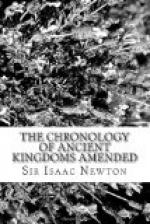Egypt was at first divided into many small Kingdoms, like other nations; and grew into one monarchy by degrees: and the father of Solomon’s Queen, was the first King of Egypt, who came into Phoenicia with an Army: but he only took Gezir, and gave it to his daughter. Sesac, the next King, came out of Egypt with an army of Libyans, Troglodites and Ethiopians, 2 Chron. xii. 3. and therefore was then King of all those countries; and we do not read in Scripture, that any former King of Egypt; who Reigned over all those nations, came out of Egypt with a great army to conquer other countries. The sacred history of the Israelites, from the days of Abraham to the days of Solomon, admits of no such conqueror. Sesostris reigned over all the same nations of the Libyans, Troglodites and Ethiopians, and came out of Egypt with a great army to conquer other Kingdoms. The Shepherds reigned long in the lower part of Egypt, and were expelled thence, just before the building of Jerusalem and the Temple; according to Manetho; and whilst they Reigned in the lower part of Egypt, the upper part thereof was under other Kings: and while Egypt was divided into several Kingdoms, there was no room for any such King of all Egypt as Sesostris; and no historian makes him later than Sesac: and therefore he was one and the same King of Egypt with Sesac. This is no new opinion: Josephus discovered it when he affirmed that Herodotus erred, in ascribing the actions of Sesac to Sesostris,




